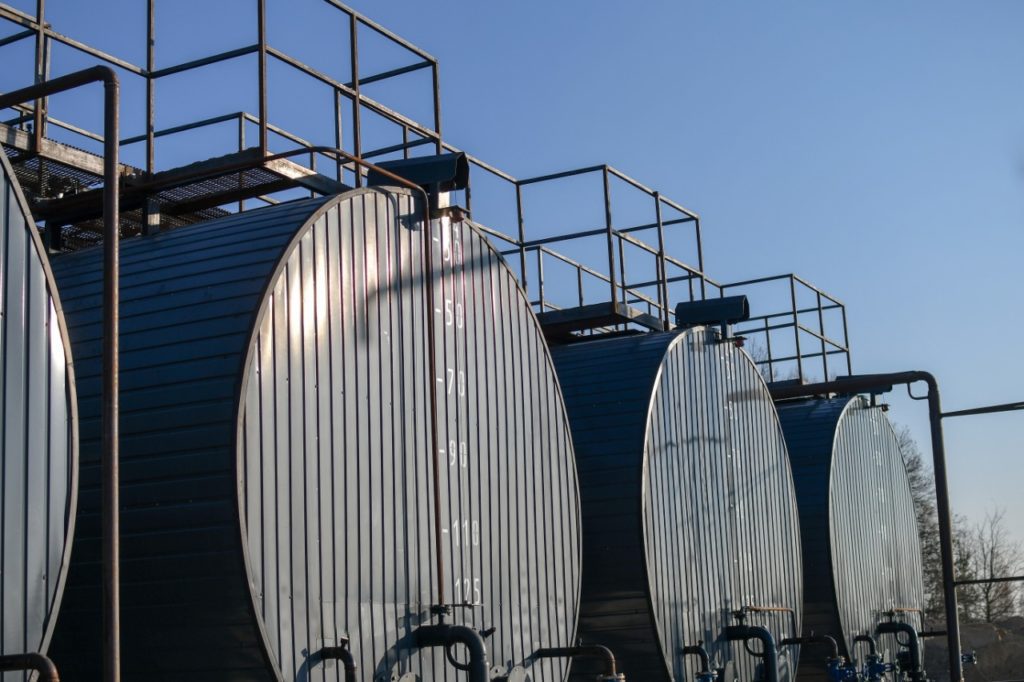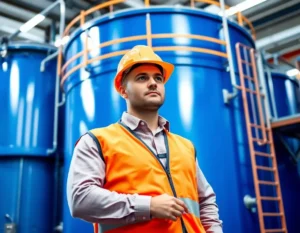In industrial sectors such as chemical, petroleum, gas, and fuel, storage tanks play a fundamental role. These tanks not only provide safe storage for large volumes of combustible materials, but they are also essential for maintaining efficiency throughout the production chain. So, how do these tanks ensure optimal containment?
In this article, we will explore in detail the fuel storage tank features that guarantee their functionality and safety. Before diving into those key specifications, it’s important to understand what a fuel storage tank is, the different types of fuels they can hold, and the material options available. Keep reading to discover more!
What are fuel storage tanks?
To understand the characteristics of a fuel storage tank, let’s start with the basics: What does storing mean? Storing involves keeping something in a way that it’s preserved in the best possible conditions. This process not only includes the reception and safeguarding of the material, but also its registration (that is, knowing the quantity being stored), and in many cases, its dosing or distribution.
A fuel storage tank is a structure specifically designed to efficiently perform these functions. In summary, a storage tank should:
- Receive the fuel.
- Record the amount stored.
- Maintain the fuel in optimal conditions.
- Facilitate its distribution when necessary.
To ensure these functions are carried out safely and efficiently, fuel storage tanks must comply with strict technical requirements, which vary according to local regulations. In all cases, safety is the priority, as handling fuel presents unique challenges and risks that require a different approach from storing other materials.

What does it mean to store fuel?
Storing fuel involves following strict regulations and applying more rigorous conditions than those used for other materials, due to the inherent risks associated with fuels. The handling of fuels during storage, production, transportation, and distribution carries significant dangers, one of the most severe being the risk of spontaneous combustion, which could lead to fires or explosions.
To minimize these risks, there are safety protocols and standards specifically designed to ensure proper fuel storage. Understanding what it means to store fuel is essential to following these procedures and preventing incidents.
A fuel is any material that, when heated, releases energy in the form of heat, making it useful. Although there are many types of fuels, from firewood to petroleum derivatives, the most commonly stored fuels today are liquid fossil fuels, such as gasoline, diesel, and ACPM (gas oil), as well as alcohols like methanol and ethanol.
Fuel storage tanks are specifically designed to contain these liquid fuels, ensuring their safe preservation.
Types of fuel storage tanks
Before exploring the key characteristics of fuel storage tanks, it’s important to understand the different types available. While all tanks must meet basic containment and safety requirements, they vary depending on their design and the type of fuel they store.
By Shape:
- Rectangular Tanks: These are less common and are usually custom-made when space or the installation site conditions require it. Due to their design, these tanks use more material in their construction, making them more expensive and less efficient in terms of capacity.
- Cylindrical Tanks: This is the most popular and functional design. Cylindrical tanks are optimized to safely store large volumes of liquid fuel. They can have one or two walls. Single-wall tanks are lighter and more economical, but double-wall tanks offer greater safety, as they are more resistant to corrosion and leaks.
- Spherical Tanks: These tanks are used to store gaseous fuels. Their spherical shape allows the gas pressure inside to distribute evenly, minimizing the risk of dangerous pressure differences.
By Disposition:
- Mobile Tanks: These tanks are mounted on vehicles to facilitate fuel transportation to hard-to-reach places. They are essential in remote areas where fuel supply is limited. Like underground tanks, they are often made of stainless steel to ensure durability and safety during transport.
- fixed tanks: Fixed or above-ground tanks are installed on the ground and are common in the chemical and petroleum industries. Their storage capacity ranges from 200,000 to 300,000 liters. These tanks require less installation preparation compared to other configurations.
- underground tanksBuried below ground level, these tanks must be extremely resistant to corrosion and leaks, making stainless steel the ideal material. They are primarily used in urban fuel distribution stations and can have a storage capacity of up to 300,000 liters.
What should be the characteristics of fuel storage tanks?
As you already saw, there are many types of fuel tanks. They have their own peculiarities, but there are certain characteristics common to all of them, which must always be taken into account. We have five characteristic areas of fuel storage tanks that we must take into account if we plan to acquire one.
Ability
More is not always better. The fuel storage needs you are looking to supply may not be exorbitant; that is, you may not need the largest tank available. To do this, you must calculate how much fuel you plan to spend, in how long, and how often it is convenient to refill the storage tank.
Quality
When we talk about quality we talk about two things, mainly: functionality and durability. The stainless steel from which our storage tanks are made, together with the meticulous design and careful manufacturing process, ensure that the tank you purchase is particularly functional and durable.
Security
As already mentioned, fuel storage is an activity that requires a lot of attention. The fuel must be handled, transported, stored and distributed with all the necessary precautions. Storage tanks, as central structures of the process, must be safe.
For this reason, they are designed to resist the ravages of atmospheric adversities and the deterioration caused by corrosive elements; in the same way, they can withstand pressures several times greater than atmospheric pressure.
Design
The design of a storage tank must take into account, mainly, the use that it is going to give. They are usually cylindrical, as they are more versatile and cheaper. They can be installed almost anywhere.
Utility
Extreme Condition Fuel Storage Tanks
When it comes to storing fuel, utility is key, especially in areas where access to supplies is limited or difficult. Storage tanks are essential in rural or remote regions, where ensuring a reliable fuel supply is vital.
At Perez Precision Works,, we offer the best fuel tanks designed to meet your most demanding needs. Discover how our tanks can make a difference in the efficiency of your operation.



